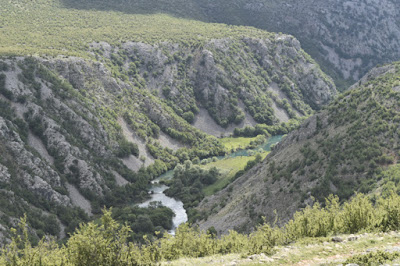Dalmatian Algyroides, Mala Paklenica
Please let me know if you disagree with any ID.
I had a very early start this morning to do some dawn sea watching near Vir, a few miles from base. My 90 minutes there produced a Scopoli's Shearwater and 3 Yelkouan Shearwaters. A Black-throated Diver and Red-necked Grebe were also seen along with several pods of Dolphins. All were distant though.
After breakfast back at the apartment I had a quick look around the woods on the campsite. More migrants had dropped in and included a female Barred Warbler, Tree Pipit, Pied Flycatcher, Garden Warbler and 2 White Storks, high, overhead. A few local Hares added to the variety. Insects included the familiar Common Heath moth and the less familiar Idaea filicata.
Common Heath, Ematurga atomaria
Idaea filicata
Pied Flycatcher, Male, Zaton Camp
The first port of call today is the Paklenica National Park. Click pictures / maps to enlarge
Mala Paklenica
Paklenica is well known for its two canyons, Velika (Big) Paklenica and Mala (Small) Paklenica. Velika Paklenica is 14km long and between 500 to 800m wide. Mala Paklenica is, unsurprisingly, smaller but is still 12km long and between 400 to 500m wide. The Park’s highest peak is Vaganski vrh, which is 1,757 metres high.A number of caves also exist in the National Park of various sizes, one of which can be visited.
The Park is well known for its numerous geological highlights, and contains a wide range of plant and animal species. Animals include Brown Bear, Lynx and Wildcat.
I went to Mala Paklenica which has far fewer people, however, your entry ticket allows access to both canyons on the same day. It is an absolute haven for all wildlife and it can be encountered at very close quarters. Reptiles included Ladder Snake, Green Wall Lizard and Dalmatian Algyroides. Birds were represented by the ubiquitous Golden Oriole, European Bee-eater, Goshawk and Eastern Orphean warbler. There were also cliff nesting Kestrels, Blue Rock Thrush and Firecrest.
Berger's Clouded Yellow, Colias alfocariensis
Egyptian Locust, Calliptamus aegypticum
Chapman's Blue, Agrodiaetus thersites (?)
Dalmatian Algyroides (Blue-throated Keeled Lizard)
Algyroides nigripunctatus, female

Gladiolius illyrica

Glanville Fritillary, Melitaea cinxia
Balkan Green Lizard, Lacerta trilineata

Green-underside Blue, Glaucopsyche alexis

Hairy Sweep, Canephora hirsuta

Iris illyrica
Northern Wall Brown, Lasiommata petropolitana

Very worn Painted Lady, Vanessa cardui

Pyramidal Orchid, Anacamptis pyramidalis
Red Pea, Lathyrus setifolius, less than 10mm across

Rose Chafer, Cetonia aurata

Fledgling Eastern Subalpine Warbler
Zeller's Beauty, Peribatodes correptaria
After lunch I headed along deserted (almost) roads towards Krupa Monastery. I say almost because as I drove along the road, toward Mt Velebit, there was a huge film crew shooting some sort of film along the entire road. They were not happy! Quel dommage, C'est la vie! ONWARDS...
Pull in at the top of the Krupa Rd off route 27
...ONWARDS! to the turn off for Krupa (sign posted) and down into a lush valley. I stopped at the top of this road and scanned the area. Ravens aplenty over the mountains along with a sub-adult Golden Eagle. There was also a pair of displaying Alpine Chough. Near the road there were several Black-headed Buntings holding territory. Two raptors kept me busy for while as they soared overhead. I eventually logged them as Common Buzzard (dark morph) and Long-legged Buzzard.
male Black-headed Bunting

Common Buzzard, photo bombed by a Bee-eater!
Common and Long-legged Buzzard comparison
Long-legged Buzzard
The final stop was Krupa monastery and the nearby meadows and gorge.

Krupa Monastery
Krupa Canyon
Krupa Monastery
Managed river flow for irrigation and milling. Hundreds of years old.
I parked on the West side of the bridge by some fresh cut meadows. It was absolutely heaving with birds!, far too many to mention here but the highlights were Crag Martin, Western Rock Nuthatch heard, 27 Honey Buzzards on the thermals, 200+ Yellow Wagtails of at least 6 races and intergrades, more Black-headed Buntings and Spanish Sparrows. There were plenty of insects including the enormous Violet Carpenter Bee, Mazarine Blue and various Skippers.
I make no apologies for trying to ID the Wagtails. Let me know if you disagree with ANY ID.
Lax-flowered Orchid, Anacamptis laxiflora
Black-headed Bunting
Mazarine Blue, Polyommatus semiargus
Spanish Sparrows
Grizzled Skipper, Pyrgus malvae
Red-underwing Skipper, Spialia sertorius
Yellow Wagtail Fest
Ashy-headed Wagtail, Motacilla flava cinerocephala males and female (bottom)
Blue-headed Wagtail, M. f. flava
"Dombrowski" intergrades (yellow throat)
Grey-headed Wagtail, M. f. thunbergi
Syke's Wagtail, M. f. beema
All the Yellow Wag pics are available for ID if requested.










































Comments
Post a Comment